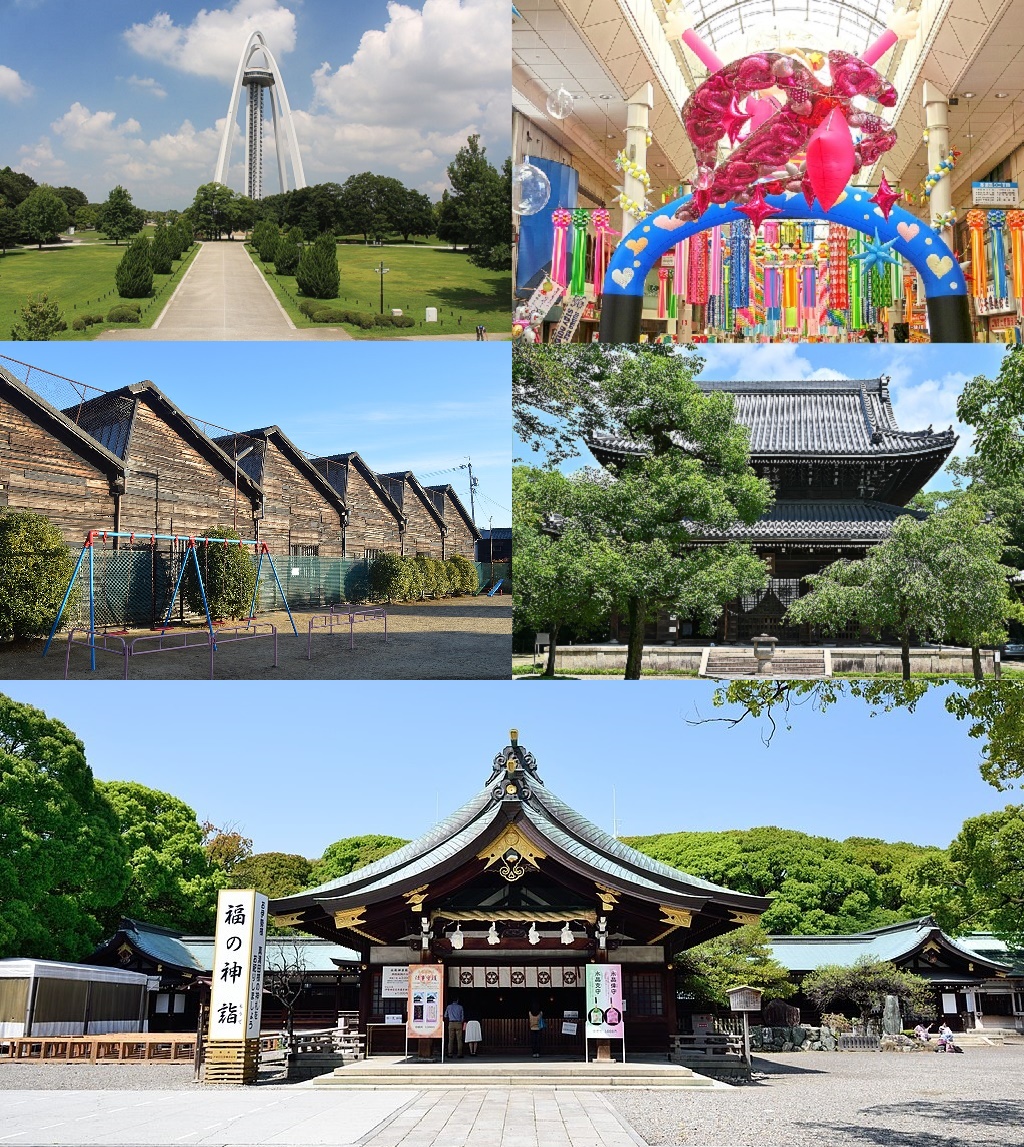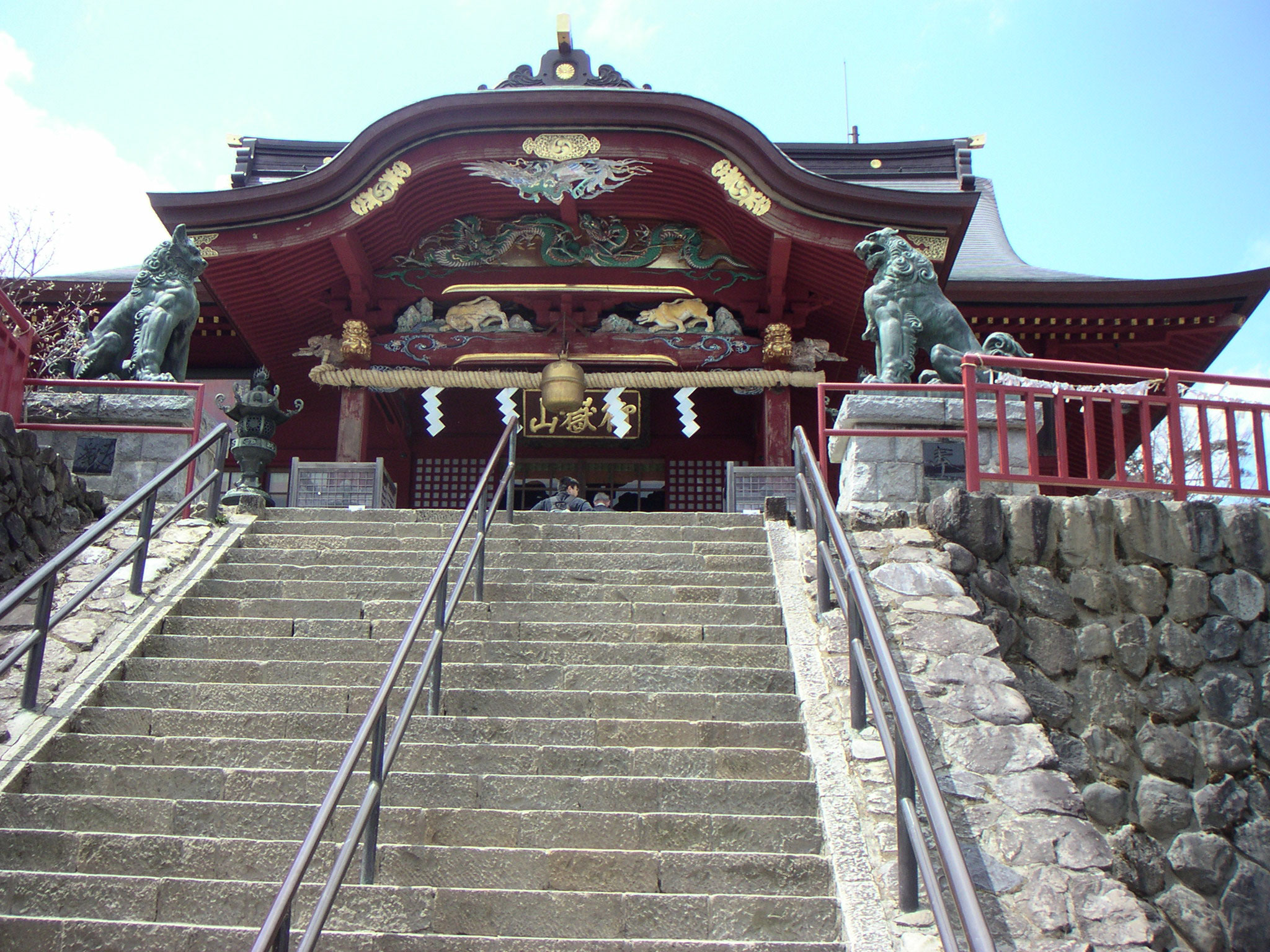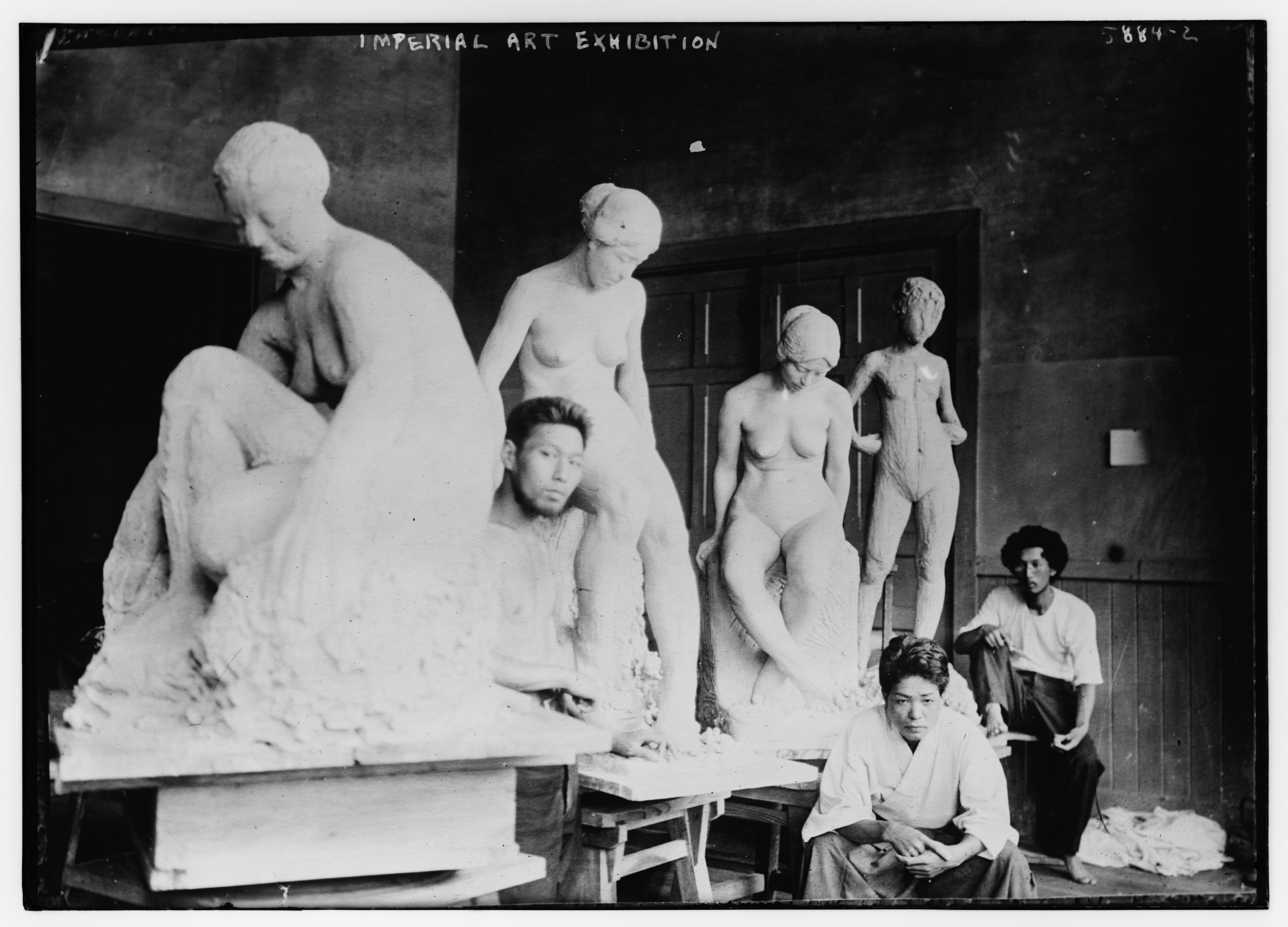|
Kawai Gyokudō
was the pseudonym of a Japanese painter in the nihonga school, active from Meiji through Shōwa period Japan. His real name was Kawai Yoshisaburō. Biography Gyokudō was born in what is now Ichinomiya city, Aichi Prefecture, as the eldest son of a paper, ink and brush merchant. In the spring of 1887, he graduated from Gifu Jinji Kogakko Elementary School, and in September, with a letter of introduction from Aoki Senbashi, entered the school of Mochizuki Gyokusen in Kyoto, where he was given the name "Gyokusyu". He went to Kyoto in 1887 to study under Kōno Bairei of the Maruyama-Shijo school of painting. In 1890, when he exhibited his work at the Industrial Exposition, he changed his name to "Gyokudo" after Gyokusen's name Tama and his grandfather's name Chikudo. In 1896, he moved to Tokyo and he became the student of Hashimoto Gahō, of the Kanō school. He also studied Western-style painting and developed a highly personal style, especially in the field of landscap ... [...More Info...] [...Related Items...] OR: [Wikipedia] [Google] [Baidu] |
Ichinomiya, Aichi
is a Cities of Japan, city located in Aichi Prefecture, Japan. The city is sometimes called Owarichinomiya to avoid confusion with other municipalities of the same name, including Ichinomiya, Aichi (town), Ichinomiya (now part of the city of Toyokawa, Aichi, Toyokawa) and Ichinomiya, Chiba, Ichinomiya in Chiba Prefecture. , the city had an estimated population of 379,654 in 161,434 households, and a population density of 3,336 persons per km2. The total area of the city was . Geography Ichinomiya is situated in western Aichi Prefecture, bordered by Gifu Prefecture to the west. The Kiso River and the Gojō River both flow through the city. Climate The city has a climate characterized by hot and humid summers, and relatively mild winters (Köppen climate classification ''Cfa''). The average annual temperature in Ichinomiya is 15.6 °C. The average annual rainfall is 1833 mm with September as the wettest month. The temperatures are highest on average in August, at around ... [...More Info...] [...Related Items...] OR: [Wikipedia] [Google] [Baidu] |
Yōga (art)
is a style of artistic painting in Japan, typically of Japanese subjects, themes, or landscapes, but using Western (European) artistic conventions, techniques, and materials. The term was coined in the Meiji period (1868–1912) to distinguish Western-influenced artwork from indigenous, or more traditional Japanese paintings, or . History Early works European painting was introduced to Japan during the late Muromachi period along with Christian missionaries from Portugal in 1543. Early religious works by Japanese artists in imitation of works brought by the missionaries can be considered some of the earliest forms of ''Yōga''. However, the sakoku, policy of national seclusion introduced by the Tokugawa bakufu in the Edo period effectively ended the influence of western art on Japanese painting, with the exception of the use of perspective (graphical), perspective, which was discovered by Japanese artists in sketches found in European medical and scientific texts importe ... [...More Info...] [...Related Items...] OR: [Wikipedia] [Google] [Baidu] |
Meiji Period
The was an era of Japanese history that extended from October 23, 1868, to July 30, 1912. The Meiji era was the first half of the Empire of Japan, when the Japanese people moved from being an isolated feudal society at risk of colonization by Western powers to the new paradigm of a modern, industrialized nation state and emergent great power, influenced by Western scientific, technological, philosophical, political, legal, and aesthetic ideas. As a result of such wholesale adoption of radically different ideas, the changes to Japan were profound, and affected its social structure, internal politics, economy, military, and foreign relations. The period corresponded to the reign of Emperor Meiji. It was preceded by the Keiō era and was succeeded by the Taishō era, upon the accession of Emperor Taishō. The rapid modernization during the Meiji era was not without its opponents, as the rapid changes to society caused many disaffected traditionalists from the former samu ... [...More Info...] [...Related Items...] OR: [Wikipedia] [Google] [Baidu] |
Important Cultural Property (Japan)
An The term is often shortened into just is an item officially classified as Tangible Cultural Property by the Japanese government's Agency for Cultural Affairs (Ministry of Education, Culture, Sports, Science and Technology) and judged to be of particular importance to the history, arts, and culture of the Japanese people. Classification of Cultural Properties To protect the cultural heritage of Japan, the Law for the Protection of Cultural Properties was created as a under which important items are appropriated as Cultural Properties,In this article, capitals indicate an official designation as opposed to a simple, unofficial definition, e.g "Cultural Properties" as opposed to "cultural properties". thus imposing restrictions to their alteration, repair and export. Besides the "designation system", there exists a , which guarantees a lower level of protection and support to Registered Cultural Properties. Cultural Properties are classified according to their nature. Items ... [...More Info...] [...Related Items...] OR: [Wikipedia] [Google] [Baidu] |
National Museum Of Modern Art, Tokyo
The , also known as MOMAT, is the foremost museum collecting and exhibiting modern Japanese art. The museum, in Chiyoda, Tokyo, Japan, is known for its collection of 20th-century art and includes Western-style and ''Nihonga'' artists. It has a branch, the National Crafts Museum (Japan), National Crafts Museum, in the city of Kanazawa. History The National Museum of Modern Art, Tokyo, was the first national museum of art in Japan and dates back to 1952, when it was established as an institution governed by the Ministry of Education. The architect of the building was Kunio Maekawa. On two later occasions, neighbouring premises were purchased and the museum was enlarged. The most recent redesign of MOMAT was conceived by Yoshirō Taniguchi (father of Yoshio Taniguchi, who designed the extension of Museum of Modern Art, MOMA in New York). Collections The collection contains many notable Japanese artists since the Meiji period, and a few contemporary Western prints. In the early yea ... [...More Info...] [...Related Items...] OR: [Wikipedia] [Google] [Baidu] |
Ōme, Tokyo
is a Cities of Japan, city located in the Western Tokyo, western portion of the Tokyo Metropolis, Japan. , the city had an estimated population of 131,128, and a population density of 1300 persons per km2. The total area of the city is . Geography Ōme is located in the Okutama Mountains of western Tokyo, bordered by Saitama Prefecture to the north. The Tama River runs from west to east almost in the center of the city area, and the Kasumi River and Naruki River, which are tributaries of the Iruma River (Arakawa River (Kantō), Arakawa River system), also flow from west to east in the north. The geography changes from the flat land in the east to the hills and mountains in the west. The highest point is 1,084 meters on Mount Nabewariyama on the right bank of the Tama River in the western end of the city. Surrounding municipalities Saitama Prefecture *Hanno, Saitama, Hanno to the north *Iruma, Saitama, Iruma to the east Tokyo Metropolis *Akiruno, Tokyo, Akiruno to the south * ... [...More Info...] [...Related Items...] OR: [Wikipedia] [Google] [Baidu] |
Government Of Japan
The Government of Japan is the central government of Japan. It consists of legislative, executive (government), executive and judiciary branches and functions under the framework established by the Constitution of Japan. Japan is a unitary state, containing forty-seven Administrative divisions of Japan, administrative divisions, with the Emperor of Japan, emperor as its head of state. His role is ceremonial and he has no powers related to the Government. Instead, it is the Cabinet of Japan, Cabinet, comprising the Prime Minister of Japan, prime minister and the Minister (government), ministers of state, that directs and controls the government and the Civil service of Japan, civil service. The Cabinet has the executive power and is formed by the prime minister, who is the head of government. The Prime Minister is nominated by the National Diet and Imperial Investiture, appointed to office by the Emperor. The current cabinet is the Second Ishiba Cabinet, which was formed on 11 ... [...More Info...] [...Related Items...] OR: [Wikipedia] [Google] [Baidu] |
Order Of Culture
The is a Japanese Order (decoration), order, established on February 11, 1937. The order has one class only, and may be awarded to men and women for contributions to Japanese Art, Japan's art, Japanese Literature, literature, science, technology, or anything related to Japanese Culture, culture in general; recipients of the order also receive an Annuity (financial contracts), annuity for life. The order is conferred by the Emperor of Japan in person on Culture Day (November 3) each year. It is considered equivalent to the highest rank (Grand Cordon) of the Order of the Rising Sun, the Order of the Sacred Treasure, and the Order of the Precious Crown. The only orders that Japanese emperors bestow on recipients by their own hands are the Collar of the Supreme Order of the Chrysanthemum, the Grand Cordon of each order, and the Order of Culture. The badge of the order, which is in gold with white enamel, is in the form of a Tachibana orange blossom; the central disc bears three cres ... [...More Info...] [...Related Items...] OR: [Wikipedia] [Google] [Baidu] |
Tokyo National University Of Fine Arts And Music
or is a school of art and music in Japan. Located in Ueno Park, it also has facilities in Toride, Ibaraki, Yokohama, Kanagawa, Kitasenju and Adachi, Tokyo. The university has trained artists in the fields of painting, sculpture, crafts, inter-media, sound, music composition, traditional instruments, art curation and global arts. History Under the establishment of the National School Establishment Law, the university was formed in 1949 by the merger of the and the , both founded in 1887. The former Tokyo Fine Arts School was then restructured as the Faculty of Fine Arts under the university. Originally male-only, the school began to admit women in 1946. The graduate school opened in 1963, and began offering doctoral degrees in 1977. The doctoral degree in fine art practice initiated in the 1980s was one of the earliest programs to do so globally. After the abolition of the National School Establishment Law and the formation of the National University Corporations on April 1, ... [...More Info...] [...Related Items...] OR: [Wikipedia] [Google] [Baidu] |
Bunten
The is a Japanese art exhibition established in 1907. The exhibition consists of five art faculties: Japanese Style and Western Style Painting, Sculpture, Craft as Art, and Sho (calligraphy). During each exhibition, works of the great masters are shown alongside works of new but talented artists. It claims to be the largest combined art exhibition of its kind in the world and the most popular in Japan. Bunten In 1907, under the supervision of the Japanese Ministry of Education, Science, Sports and Culture, then called Mombushō (文部省), the first state art exhibition took place, the Monbushō Bijutsu Tenrankai (文部省 美術展 覧 会), abbreviated to "bunten" (文 展). It was held at the Tokyo Metropolitan Art Museum (東京都美術館, Tōkyō-to Bijutsukan.)It had the three faculties: Japanese Style Painting, Western Style Painting and Sculpture. Works were approved after being examined by a jury. The series of exhibitions took place twelve times under this na ... [...More Info...] [...Related Items...] OR: [Wikipedia] [Google] [Baidu] |
Japan Fine Art Academy
Japan is an island country in East Asia. Located in the Pacific Ocean off the northeast coast of the Asia, Asian mainland, it is bordered on the west by the Sea of Japan and extends from the Sea of Okhotsk in the north to the East China Sea in the south. The Japanese archipelago consists of four major islands—Hokkaido, Honshu, Shikoku, and Kyushu—and List of islands of Japan, thousands of smaller islands, covering . Japan has a population of over 123 million as of 2025, making it the List of countries and dependencies by population, eleventh-most populous country. The capital of Japan and List of cities in Japan, its largest city is Tokyo; the Greater Tokyo Area is the List of largest cities, largest metropolitan area in the world, with more than 37 million inhabitants as of 2024. Japan is divided into 47 Prefectures of Japan, administrative prefectures and List of regions of Japan, eight traditional regions. About three-quarters of Geography of Japan, the countr ... [...More Info...] [...Related Items...] OR: [Wikipedia] [Google] [Baidu] |







